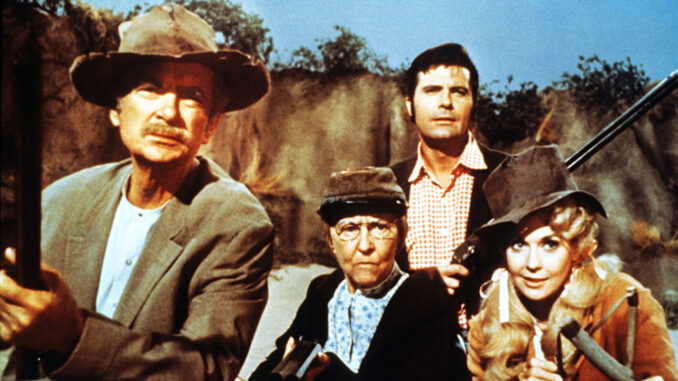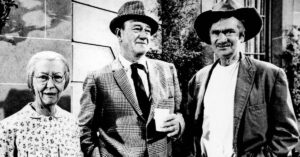
It was a rural revolution. The 1960s were filled with TV comedies populated by simple country folk.
The trend started in the late 1950s. The Real McCoys premiered on ABC in 1957, eventually moving to CBS for its final season in 1962-63. It features Walter Brennan as Amos McCoy, an elderly farmer who migrated to California from West Virginia with his grandson, Luke (Richard Crenna), and other young family members.
Although that series primed the pump, CBS fortified TV’s down-home flavor with several others. The Andy Griffith Show kick-started things in 1960, casting Griffith as Andy Taylor, the sheriff of Mayberry, a fictional North Carolina town brimming with colorful characters, including Taylor’s bumbling deputy, Barney Fife (Don Knotts), a barber named Floyd (Howard) McNear) and a dimwitted gas-station attendant, Gomer Pyle (Jim Nabors).
A regular fixture on TV’s Top 10 list, The Andy Griffith Show wrapped its fourth season with an episode that spawned another huge hit. Gomer Pyle, U.S.M.C. surfaced in 1964, focusing on its title character, who leaves Mayberry to join the U.S. Marine Corps, and spinning many stories around the personality clash between Gomer and his tightly wound sergeant, Vince Carter (Frank Sutton).
When Griffith decided to leave his series, CBS chose to carry on without him, producing a 1968 sequel called Mayberry R.F.D. Featuring Ken Berry as a widower named Sam Jones, the show’s debut scored huge ratings with a storyline built around the wedding of Andy Taylor and his sweetheart, Helen Crump (Aneta Corsaut).
CBS had rated gold with Cornpone comedy

The Beverly Hillbillies made its debut in 1962, spinning a rags-to-riches story around “poor mountaineer” Jed Clampett (Buddy Ebsen), who strikes oil on his farm and moves to Beverly Hills with his daughter Elly May (Donna Douglas), his nephew Jethro (Max Baer Jr.) and his mother-in-law “Granny” (Irene Ryan). The show became TV’s top-rated series for a couple of seasons. Several episodes still rank among the most watched in TV history.
The culture clash of The Beverly Hillbillies led CBS to cook up Petticoat Junction in 1963. It revolved around a fictional town called Hooterville, home to a steam-driven train called the Cannonball and a hotel named the Shady Rest. Bea Benaderet played Kate Bradley, who ran the hotel with her uncle Joe Carson (Edgar Buchanan). Also on hand are Kate’s gorgeous daughters: Billie Jo (played by Jeannine Riley and, later, Gunilla Hutton and Meredith MacRae), Bobbie Jo (Pat Woodell and, later, Lori Saunders) and Betty Jo (Linda Kaye Henning).
Petticoat Junction reverses the fish-out-of-water focus of The Beverly Hillbillies, plunking city slickers into rural surroundings. It worked so well that it spawned a spinoff in the same locale. Green Acres hit screens in 1965, with Eddie Albert as Oliver Wendell Douglas, a Manhattan lawyer who moves to a run-down Hooterville farm with his glamorous wife, Lisa (Eva Gabor).
Hee-Haw Joins the fun of Prime Time Variety TV
Buoyed by its rural sitcoms, CBS added another dimension in 1969 with Hee Haw, a show that emulated NBC’s Rowan & Martin’s Laugh-In. Unlike Laugh-In’s urban/hippie flavor, Hee Haw relies on a country comedy/variety mix hosted by Buck Owens and Roy Clark and featured hayseed characters played by Junior Samples, Grandpa Jones, Minnie Pearl and many others.
Although CBS rode a huge wave of popularity with its country comedies, audience demographics became a bigger factor in the Nielsen ratings as the 1960s wore on. Success began to be measured not only by how many people were watching a show, but also by who those people were. And networks began to court audiences that appeal to advertisers — young viewers in big cities rather than small towns.
The shift led CBS to carry out its notorious “Rural Purge.” Even though The Beverly Hillbillies, Green Acres, Mayberry R.F.D. and Hee Haw were still massive hits, CBS canceled them all by the end of the 1970-71 season, making way for shows aimed at younger demographics: The Mary Tyler Moore Show, All in the Family and other urban-themed newcomers.
It was a controversial move. And although Hee Haw produced new episodes in syndication until 1992, the others all simply fell by the wayside, ending one of the most colorful eras in TV history.
